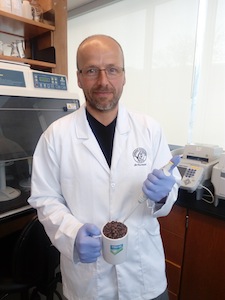
DNA doesn’t lie: new technology authenticates food ingredients
Food in Canada
Food In Canada Business Operations Exporting & Importing Food Safety Food Trends Processing Products Regulation Bake & Snack Food Beverages Confectionery Dairy Fruit & Vegetables Grain & Oilseed Milling Health & Wellness Ingredients & Additives Meat &Poultry Pet Food Seafood Specialty Foods food manufacturers University of GuelphA University of Guelph professor is helping food manufacturers verify whether their products contain adulterated ingredients or not

By Jane Robinson
Guelph – Now that scientists can barcode and catalogue the unique DNA sequence of any living being, they’re putting the technology to the test to authenticate food products.
University of Guelph professor Steven Newmaster is helping food manufacturers verify the products they use don’t contain any adulterated ingredients.
 University of Guelph scientists invented DNA barcoding in 2003, starting with animals and plants and identifying more than 60,000 plant species to date. Newmaster, the director of the Natural Health Products (NHP) Research Alliance at Guelph, wondered how the catalogued information could be used by the food and NHP industry.
University of Guelph scientists invented DNA barcoding in 2003, starting with animals and plants and identifying more than 60,000 plant species to date. Newmaster, the director of the Natural Health Products (NHP) Research Alliance at Guelph, wondered how the catalogued information could be used by the food and NHP industry.
He began by using the previous barcoding work to create new libraries of DNA information for commercial plant species used in agriculture and food. Now, he’s successfully created a new tool to deal with food fraud – the practice of using lower cost substitute ingredients in the food industry – that will soon be installed by food manufacturers for on-site testing.
“With a shrinking food supply and a population headed to nine billion, there is tremendous pressure on the supply chain, and contamination or substitution of ingredients may become more tempting for some companies,” says Newmaster.
Together with Rob Hanner (chief technology officer), Newmaster started TRU-ID, a Guelph-based biotech company, to commercialize the university’s DNA barcoding technology. TRU-ID offers a certification program for food companies including health food and nutraceutical industries to verify the authenticity of their products.
“We can test any ingredient from halibut to broccoli to Echinacea in order to authenticate it for a food manufacturer,” says Newmaster, chief science officer of TRU-ID. “The technology and technique we use is applicable to any plant or animal based product.”
Companies are using TRU-ID to ensure their supply chain is high quality, testing along the production process from raw ingredients and finished products. Customers like vitamin /supplement giants Jamieson and Nature’s Way include the TRU-ID Certification Mark on every package to certify the ingredients are authentic.
“One of the big benefits of this technology is true sustainability and biodiversity,” says Newmaster. “We can make sure we are using commercial ingredients and not depleting uncommon, wild species of fish or rare medicinal plant species.”
It currently takes TRU-ID about 10-14 days to test products, which includes extracting a DNA sample and comparing it to an extensive database to certify authenticity. The next innovation – expected sometime in 2018 – will take TRU-ID’s process right into food manufacturers where ingredients are tested on site and verified against the DNA database in about an hour. Faster results will help companies make quicker, more effective and efficient decisions.
From there, Newmaster sees the technology eventually moving right into a consumer’s palm.
“We’re working on microfluidic devices that put the lab on a microchip in a phone or tablet. So someday, consumers could scan a food sample for fast and accurate comparison against a DNA library to find out if food is authentic,” he says.
Photo courtesy of S. Newmaster, University of Guelph
This article is provided by AgInnovation Ontario, a project of the Agri-Technology Commercialization Centre (ATCC). The ATCC is funded by Growing Forward 2, a federal-provincial-territorial initiative.
Print this page